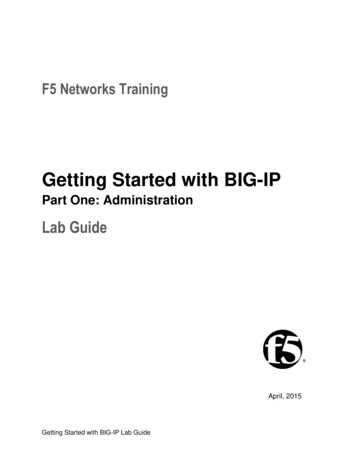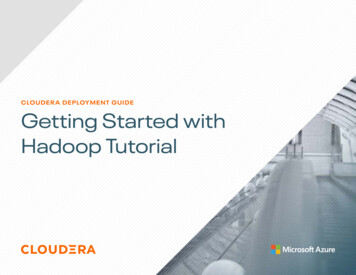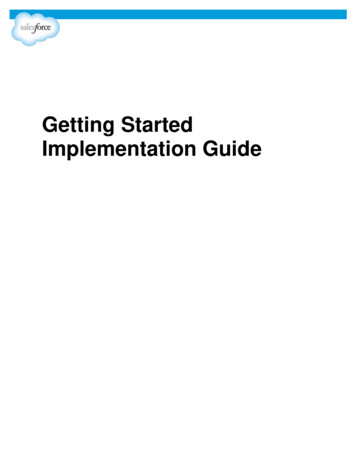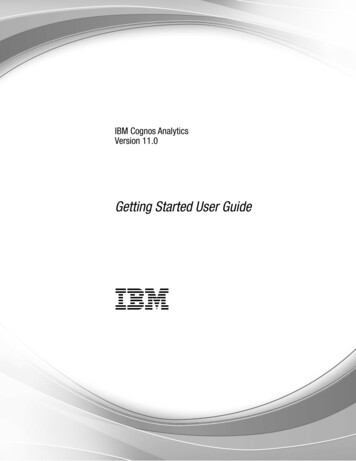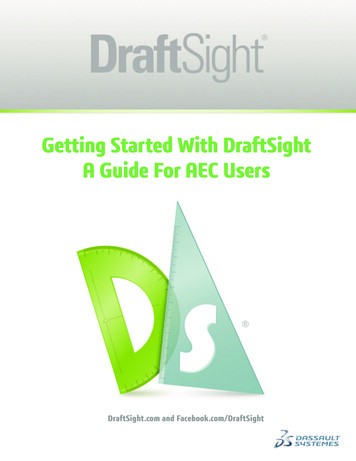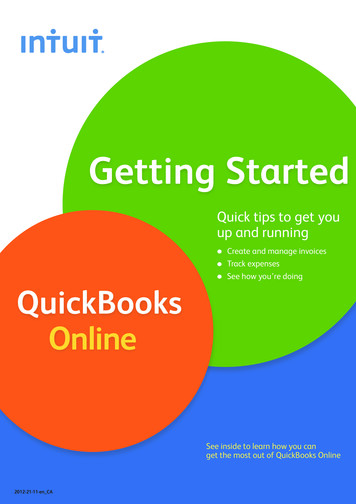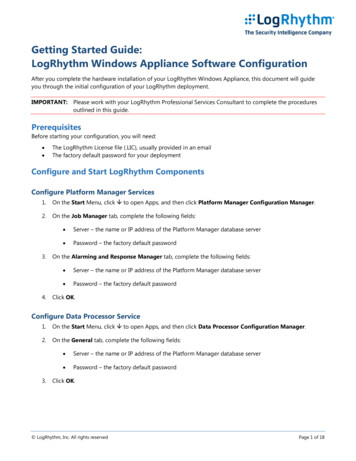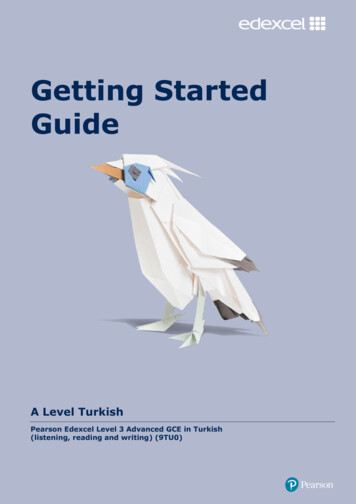
Transcription
Getting StartedGuideA Level TurkishPearson Edexcel Level 3 Advanced GCE in Turkish(listening, reading and writing) (9TU0)
Getting Started Guide:A Level TurkishContents1 Introduction32 What’s changed?42.1 AS has not been redeveloped42.2 Changes to A level qualifications4Aims and objectives4Themes4Prescribed works4Summarising information4Independent research skills4Assessment Objectives52.3 Specification overview5Assessment structure5Specification content5Comparison of reformed and legacy specifications63 Planning93.1 Planning a linear A level course93.2 Suggested resources104 Content guidance114.1 Themes and sub-themes114.2 Prescribed works115 Assessment guidance125.1 Breakdown of Assessment Objectives125.2 Assessment overview125.3 Understanding how to apply the mark grids136 Subject advisor support216 Pearson Education Ltd 2018 Copying permitted for purchasing institution only. This material is not copyright free.
1 IntroductionOur A level qualifications are designed to be appealing and engaging to students, while preparingthem for future study and work. We have developed inspiring and culturally relevant coursesbased on feedback from teachers, students, subject associations, academics and advisors.The qualification has a clear structure, which will enable students to develop advanced-level,transferable language alongside a deeper cultural appreciation of Turkey and Cyprus andTurkish-speaking culture. There is an emphasis on promoting understanding of grammar to allowspontaneous, creative use of language to suit different purposes. The themes are engaging andrelevant, combining familiar and new content. Popular texts and films have been chosen, bothclassical and contemporary.Pearson is strongly committed to maintaining the availability of a wide range of language Alevels. Although some awarding organisations are ceasing to offer those language A levels onlytaken by a limited number of students, we believe these qualifications make an importantcontribution to fostering diversity and community cohesion.We are redeveloping A levels in: Arabic Greek Japanese UrduAnd we are developing the following A levels for the first time: Gujarati Persian Portuguese TurkishNote that we have taken the decision not to develop AS qualifications in any of these languages.This Getting Started Guide provides an overview of the new A level Turkish specification, to helpyou get to grips with the changes to content and assessment. Pearson Education Ltd 2018 Copying permitted for purchasing institution only. This material is not copyright free.3
2 What’s changed?2.1 AS has not been redevelopedOur discussions with school and colleges have indicated that, under the new system, in which ASresults no longer count towards A level grades, take-up of AS level will be very limited. For thisreason we have taken the decision only to offer the full linear A level in the languages beingdeveloped for first teaching in 2018.2.2 Changes to A level qualificationsFrom September 2018, A level Turkish will be a fully linear qualification. This means that allexaminations must be sat at the end of the course. More information about the implications ofthe move to linear assessment is given on page 8.Separate subject criteria have been developed for these languages with smaller cohorts. Whilethe level of rigour and demand will be the same, there will be no requirement for students todemonstrate spoken language skills.Aims and objectivesThere is a new set of aims and objectives for this A level. As a result, students are now requiredto: study two works from a prescribed list summarise information from spoken and written sources in writing develop independent research skills undertake a task integrating the skills of listening, reading and writing translate from and into the target language.ThemesThe specification content is broken down into four themes relating to the target language culture.Two themes relate to ‘society, past and present’, and two themes relate to ‘political and/orintellectual and/or artistic culture, past and present’.Prescribed worksIn the specification, we have specified a list of prescribed works in the target language, includingliterary texts and films. Students must study either one literary text and one film, or two literarytexts. Knowledge and understanding of works will be assessed in Paper 2 (Translation into targetlanguage and written response to works).Summarising informationThis is a new requirement testing students’ ability to summarise information. Students should beable to: identify the main ideas summarise a line of argument and/or different points of view evaluate and draw conclusions.Ability to summarise will be assessed in Paper 3 (Listening, reading and writing in Turkish),question 5(c).Independent research skillsStudents will be required to develop as independent researchers through the study of language.Students are required to select one research subject from the four given in the specification andundertake independent research on all three aspects. Students will have to demonstrateknowledge and understanding of the research subject in Paper 1 (Translation into English,reading comprehension and writing (research question) in Turkish).4 Pearson Education Ltd 2018 Copying permitted for purchasing institution only. This material is not copyright free.
Assessment ObjectivesThe A level languages Assessment Objectives have been revised.There are two main changes to the Assessment Objectives: A new AO4 has been introduced. This requires knowledge and understanding of, and criticaland analytical response to, cultural and social issues relating to countries where the targetlanguage is spoken. AO3 has a greater proportion of the marks than in the previous specification, and has asubtly changed emphasis – there is greater emphasis now on active application of grammarin generating new, independent language.AO120%AO230%AO330%AO420%Understand and respond in writing to spoken language drawn from avariety of sourcesUnderstand and respond in writing to written language drawn from avariety of sourcesManipulate the language accurately, in written forms, using a range oflexis and structuresShow knowledge and understanding of, and respond critically andanalytically to, different aspects of the culture and society of thecountries where the language is spoken2.3 Specification overviewAssessment structurePaper 1Translation into English, readingcomprehension and writing (research question)in Turkish2 hours 30 minutes40%Paper 2Translation into Turkish and written responsesto works2 hours 40 minutes30%Paper 3Listening, reading and writing in Turkish2 hours 15 minutes30%Specification contentSpecification content is now based around social, political and cultural themes, relating to theTurkish language, culture and communities. This will enable students to gain a deeperunderstanding of the culture related to their language of study, and ensure smooth progressionto further study.Themes 1, 3 and 4 focus on aspects of the society of Turkey only. Theme 2 focuses on aspectsof the artistic and political culture of Turkey and Cyprus.Students will study four themes: Theme 1: Society past and present (Changes in Turkish society) Theme 2: Artistic culture past and present (Art and culture in Turkey and Cyprus) Theme 3: Society past and present (Perspectives on Turkey) Theme 4: Political culture past and present (Political issues in Turkey)There are a number of sub-themes, which can be found on page 6. The questions in the questionpapers are set within the context of these themes. Pearson Education Ltd 2018 Copying permitted for purchasing institution only. This material is not copyright free.5
Students are also required to undertake independent research based on one of the four researchsubjects listed in the specification. Students must research all three aspects within the researchsubject. Research subjects and aspects are as follows: Education opportunities in Turkey Change in traditional celebrations Tourism in Turkey Immigrants in Turkey since 2015Comparison of reformed and legacy specificationsReformed specificationTheme 1Theme 2Theme 36Changes in Turkish society Family and relationships The world of work Research subject: Educationopportunities in TurkeyArt and culture in Turkey andCyprus Modern culture and media Traditional art culture Research subject: Change intraditional celebrationsPerspectives on Turkey Human geography Environment Research subject: Tourism inTurkeyLegacy specificationSome related content wascovered in the legacyspecification under the A2Society sub-topic‘Unemployment: causes andconsequences (local, national orglobal)’.Some related content wascovered in the legacyspecification under the A2Culture sub-topics ‘Literature andthe arts: trends, changes,influences and impacts onindividuals and society’ and‘Heritage and history: influenceand impacts of heritage(including colonial heritage) andhistorical events oncontemporary society’.Some related content wascovered in the legacyspecification under the A2Environment sub-topics: The individual and theenvironment: recycling;changing individual impact;local conservation Energy management:alternative energy sources,changing use of fossil fuels;nuclear energy; changingenergy demands Pollution: causes;consequences; solutions Conservation of the naturalworld: changing habitats;impact of man and pollution;local, national or globalinitiatives. Pearson Education Ltd 2018 Copying permitted for purchasing institution only. This material is not copyright free.
Theme 4Literary worksPolitical issues in Turkey Atatürk’s revolutions in Turkey Political scene Research subject: Immigrantsin Turkey since 2015Prescribed list of works: Üç Anadolu Efsanesi, YaşarKemal, 1967 (short stories) Veda, Ayşe Kulin, 2008 (novel) Sessiz Ev, Orhan Pamuk, 1983(novel)Some related content wascovered in the legacyspecification under the A2Culture sub-topic ‘Heritage andhistory: influence and impacts ofheritage and historical events oncontemporary society’ and theSociety sub topic ‘Integration andexclusion: age; gender; race;religion; equality of opportunity’.Study of literary works notcompulsory. Students couldchoose to study one of theprescribed texts for Unit 2Section C.Students are expected to produceresponses that relate to featuressuch as:Films form and technique key themes, concepts andissues characterisation plot structure social and cultural settingPrescribed list of films: İftarlık Gazoz, director YükselAksu (2016) Çınar Ağacı, director Handanİpekçi (2011) Dedemin İnsanları, directorÇağan Irmak (2011)Study of film not required.Students are expected to produceresponses that relate to featuressuch as: form and technique key themes, concepts andissues characterisation plot structure social and cultural setting Pearson Education Ltd 2018 Copying permitted for purchasing institution only. This material is not copyright free.7
IndependentresearchMust be based on one of the fourresearch subjects listed in thespecification: Education opportunities inTurkey Change in traditionalcelebrations Tourism in Turkey Immigrants in Turkey since2015Must link to Turkish cultureand/or society: chosen from alist of prescribed topics and textsin the specification.Students must research all threeaspects of their chosen researchsubjectN/A8No equivalent in new specificationA2 Society sub-topic ‘Law andorder’ and A2 Science andtechnology: impact and issuessub-topics do not appear in thereformed qualification. Pearson Education Ltd 2018 Copying permitted for purchasing institution only. This material is not copyright free.
3 Planning3.1 Planning a linear A level courseThe key difference with a linear A level is that all exams are taken at the end of the (usually)two-year course. As a result, it is not possible to retake individual exams – rather, if you wish toretake, you must retake the entire qualification.In terms of language learning, this is a logical and positive development because students mustretain and build on everything they learn in order to master a language effectively.Course planning needs to cover: four themes either two literary texts, or a literary text and a film sufficient practice in listening, reading, writing and translation a broad range of grammar, and opportunities to use this to generate language independently independent research of selected research subject development of critical and analytical thinking.Year 1Theme 1Year 2Theme 3Theme 4Literary work/FilmRevisiondevelopmentLiterary work/FilmRevision/Theme 2SkillsResearchDevelop skills/researchall aspects of chosenresearch subjectGrammarTransferable listening,reading, writing,translation, thinkingHere is just one way in which you might structure a two-year course: Pearson Education Ltd 2018 Copying permitted for purchasing institution only. This material is not copyright free.9
3.2 Suggested resourcesOur free online support for A level Turkish, which can be accessed on our website, includesguides on: teaching literature teaching film how to analyse a text or film how to develop research skills.Other useful resources include:GrammarTürkçe Dilbilgisi, Mehmet Hengirmen, 2003, Engin YayıneviTürkçe Dilbilgisi, M.Kaya Bilgegil, 2014, Salkım Söğüt YayınlarıTürkçe Dilbilgisi Öğretme Kitabı, Feyza Hepçilingirler, 2018, kırmızı KediThese books can be ordered at www.hepsiburada.comIn addition the website www.tdk.gov.tr can be very useful for candidates and teachers.LiteratureÜç Anadolu Efsanesi, Yaşar Kemal, 1967, Yapı Kredi YayınlarıVeda, Ayşe Kulin, 2008, EverestSessiz Ev, Orhan Pamuk, 1983, Yapı Kredi YayınlarıThe books can be ordered at www.dr.com.tr /www.akakce.com / www.idefix.comFilmsAll films can be watched on www.youtube.com, www.sinematurk.com or www.beyazperde.com.Information about the directors can be found in many search engines.Newspapers, television and radioTRT1 radio station has a variety programmes related to the Turkish A
Paper 2 Translation into Turkish and written responses to works 2 hours 40 minutes 30% Paper 3 Listening, reading and writing in Turkish 2 hours 15 minutes 30% Specification content Specification content is now based around social, political and cultural themes, relating to the Turkish language, culture and communities. This will enable students to gain a deeper understanding of the culture .



